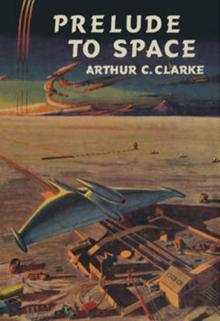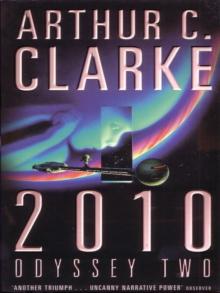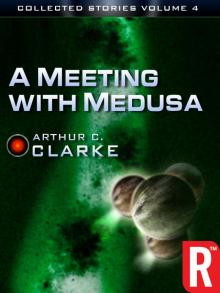- Home
- Arthur C. Clarke
The Light of Other Days Page 10
The Light of Other Days Read online
Page 10
“I know what the FBI is.” Hiram thumped his desk, frustrated. “One bloody thing after another.”
At last, Kate thought.
Hiram glared at her. “Just watch what you say to this arsehole.”
She frowned. “This government-appointed law enforcement arsehole from the FBI, you mean? Even you answer to the law, Hiram. I’ll say what I think best.”
He clenched a fist, seemed ready to say more, then just shook his head. He stalked to his picture window, and the blue light of the sky, filtered through the tinted glass, evoked highlights from his bald pate. “Bloody hell,” he said. “Bloody, bloody hell.”
•
Michael Mavens, FBI Special Agent, wore the standard issue charcoal-grey suit, collarless shirt and shoelace tie. He was blond, whiplash thin, and he looked as if he had played a lot of squash, no doubt at some ultra-competitive FBI academy.
He seemed remarkably young to Kate: no more than mid- to late twenties. And he was nervous, dragging awkwardly at the chair Hiram offered him, rumbling with his briefcase as he opened it and dug out a SoftScreen.
Kate glanced at Hiram. She saw calculation in his broad, dark face; Hiram had spotted this agent’s surprising discomfort too.
After showing them his badge, Mavens said, “I’m glad to find you both here, Mr. Patterson, Ms. Manzoni. I’m investigating an apparent security breach.”
Hiram went on the attack. “What authorization do you have?”
Mavens hesitated. “Mr. Patterson, I’m hoping we can all be a little more constructive than that.”
“Constructive?” Hiram snapped. “What kind of answer is that? Are you acting without authorization?” He reached for a telephone icon in his desktop.
Mavens said calmly, “I know your secret.”
Hiram’s hand hovered over the glowing symbol, then withdrew.
Mavens smiled. “Search Engine. Security cover FBI level three four, authorization Mavens M. K. Confirm please.”
After a few seconds, the Search Engine reported back, “Cover in place. Special Agent Mavens.”
Mavens nodded. “We can speak openly.”
Kate sat down opposite Mavens, intrigued, puzzled, nervous.
Mavens spread his SoftScreen flat on the desktop. It showed a picture of a big white-capped military helicopter. Mavens said, “Do you recognize this?”
Hiram leaned closer. “It’s a Sikorsky, I think.”
“Actually a VH-3D,” said Mavens.
“It’s Marine One,” said Kate. “The President’s helicopter.”
Mavens eyed her. “That’s right. As I’m sure you both know, the President and her husband have spent the last couple of days in Cuba at the UN hydrology conference. They’ve been using Marine One out there. Yesterday, during a short flight, a brief and private conversation took place between President Juarez and English Prime Minister Huxtable.” He tapped the ’Screen, and it revealed a blocky schematic of the helicopter’s interior. “The Sikorsky is a big bird for such an antique, but it is packed with communication gear. It has only ten seats. Five are taken up by Secret Service agents, a doctor, and military and personal aides to the President.”
Hiram seemed intrigued. “I guess one of those aides has the football.”
Mavens looked pained. “We don’t use a ‘football’ any more, Mr. Patterson. On this occasion the other passengers, in addition to President Juarez herself, were Mr. Juarez, the chief of staff, Prime Minister Huxtable and an English security agent.
“All of these people — and the pilots — have the highest possible security clearances, which in the case of the agents and other staff are checked daily. Mr. Huxtable, of course, despite his old-style title, holds an office equivalent to a state governor. Marine One itself is swept several times a day. Despite your virtual melodramas about spies and double agents, Mr. Patterson, modern anti-surveillance measures are pretty foolproof. And besides, the President and Mr. Huxtable were isolated in side a security curtain even within the Sikorsky. We don’t know of any way those various levels of security can be breached.” He turned his pale brown eyes on Kate. “And yet, apparently, they were.
“Your news report was accurate, Ms. Manzoni. Juarez and Huxtable did hold a conversation about the possibility of a military solution to England’s dispute with Scotland over water supplies.
“But we have testimony from Mr. Huxtable that his speculation about invading Scotland is — was — private and personal. The notion is his, he hadn’t committed it to paper or electronic store, or discussed it with anybody, not his Cabinet, not even his partner. His conversation with President Juarez was actually the first time he’d articulated the idea out loud, to gauge the extent of the President’s support for such a proposal, if formulated.
“And at the time you broke the story, neither the Prime Minister nor the President had discussed this with anybody else.” He glared at Kate, “Ms, Manzoni, you see the situation. The only possible source for your story is the Juarez-Huxtable conversation itself.”
Hiram stood beside Kate. “She’s not going to reveal her sources to a goon like you.”
Mavens rubbed his face and sat back. “I have to tell you, sir, that bugging the Prez is going to land you with a list of federal charges as long as your arm. An interagency team is investigating this matter. And the President is pretty angry herself. OurWorld could be shut down. And you, Ms. Manzoni, will be lucky to evade jail.”
“You’ll have to prove it first,” Hiram blustered. “I can testify that no OurWorld operative has been anywhere near Marine One, to plant a bug or to do anything else. This interagency investigation team you run…”
Mavens coughed. “I don’t run it. I’m part of it. In fact the Bureau chief himself…”
Hiram’s mouth dropped open. “And does he know you’re here? No? Then what are you trying to do here, Mavens? Set me up? Or — blackmail? Is that it?”
Mavens looked increasingly uncomfortable, but he sat still.
Kate touched Hiram’s arm. “I think we’d better hear him out, Hiram.”
Hiram shook her away. He turned to the window, hands caged behind his back, his shoulders working with anger.
Kate leaned toward Mavens. “You said you knew Hiram’s secret. What did you mean?”
And Michael Mavens started talking about wormholes.
The map he produced from his briefcase and spread over the table was hand-drawn on unheaded paper. Evidently, Kate thought, Mavens was straying into speculations he hadn’t wanted to share with his FBI colleagues, or even commit to the dubious security of a SoftScreen.
He said, “This is a map of the route Marine One took yesterday, over the suburbs of Havana. I’ve marked time points with these crosses. You can see that when the key Juarez-Huxtable onboard conversation took place — it only lasted a couple of minutes — the chopper was here.”
Hiram frowned, and tapped a hatched box highlighted on the map, right under the Sikorsky’s position at the start of the conversation. “And what’s this?”
Mavens grinned. “It’s yours, Mr. Patterson. That is an OurWorld DataPipe terminal. A wormhole mouth, linking to your central facility here in Seattle. I believe the DataPipe terminal under Marine One is the mechanism you used to get your information from the story.”
Hiram’s eyes narrowed.
Kate listened, but with growing abstraction, as Mavens speculated — a little wildly — about directional microphones and the amplifying effects of the gravitational fields of wormhole mouths. His theory, as it emerged, was that Hiram must be using the fixed DataPipe anchors to perform his bugging.
It was obvious that Mavens had stumbled on some aspects of the truth, but didn’t yet have it all.
“Bull,” said Hiram evenly. “There are holes in your theory I could fly a 747 through.”
“Such as,” Kate said gently, “OurWorld’s ability to get cameras to places where there is no DataPipe wormhole terminal. Like those hurricane-struck Philippine islands. Or Secretary-General H
alliwell’s cleavage.”
Hiram glared at Kate warningly. Shut up.
Mavens looked confused, but dogged. “Mr. Patterson, I’m no physicist. I haven’t yet figured out all the details. But I’m convinced that just as your wormhole technology is your competitive advantage in data transmission, so it must be in your news-gathering operations.”
“Oh, come on, Hiram,” she said. “He has most of it.”
Hiram growled, “Damn it, Manzoni. I told you I wanted plausible deniability at every stage.”
Mavens looked inquiringly at Kate.
She said, “He means, cover for the existence of the WormCams.”
Mavens smiled. “WormCams. I can guess what that means. I knew it.”
Kate went on, “But deniability wasn’t always possible. And not in this case. You knew it, Hiram, before you approved the story. It was just too good a lead to pass on… I think you should tell him what he wants to know.”
Hiram glared at her. “Why the hell should I?”
“Because,” said Mavens, “I think I can help you.”
•
Mavens stared wide-eyed at David’s first wormhole mouth, already a museum piece, the spacetime pearl still embedded in its glass block. “And you don’t need anchors. You can plant a WormCam eye anywhere, watch anything… And you can pick up sound too?”
“Not yet,” Hiram said. “But the Search Engine is a pretty good lipreader. And we have human experts to back it up. Now, Special Agent. Tell me how you can help me.”
Reluctantly, Mavens set the glass block down on the table. “As Ms. Manzoni deduced, the rest of my team is only a couple of steps behind me. There will probably be a raid on your facilities tomorrow.”
Kate frowned. “Then surely you shouldn’t be here, tipping us off.”
“No, I shouldn’t,” Mavens said seriously. “Look, Mr. Patterson, Ms. Manzoni, I’ll be frank. I’m arrogant enough to believe that on this issue I can see a little more clearly than my superiors, which is why I’m stepping over the mark. Your WormCam technology — even what I was able to deduce about it for myself — is fantastically powerful. And it could do an immense amount of good: bringing criminals to justice, counterespionage, surveillance.”
“If it was in the right hands,” Hiram said heavily.
“If it was in the right hands.”
“And that means yours. The Bureau’s.”
“Not just us. But in the public domain, yes. I can’t agree with your reporting of the Juarez-Huxtable conversation. But your exposure of the fraudulent science behind the Galveston desalination project, for example, was a masterful piece of journalism. By uncovering that particular scam alone you saved the public purse billions of dollars. I’d like to see responsible news-gathering of that kind continue. But I am a servant of the people. And the people — we — need the technology too, Mr. Patterson.”
“To invade citizens’ privacy?” Kate asked.
Mavens shook his head. “Any technology is open to abuse. There would have to be controls. But — you may not believe it, Ms. Manzoni — on the whole we civil servants are pretty clean. And we need all the help we can get. These are increasingly difficult times, as you must know, Ms. Manzoni.”
“The Wormwood.”
“Yes.” He frowned, looking troubled. “People seem reluctant to take responsibility for themselves, let alone for others, their community. A rise in crime is being matched by a rise in apathy about it. Presumably this will only grow worse as the years go by, as the Wormwood grows closer.”
Hiram seemed intrigued. “But what difference does it make if the Wormwood is going to cream us all anyhow? When I was a kid in England, we grew up believing that when the nuclear war broke out we’d have just four minutes’ warning. We used to talk about it. What would you do with your four minutes? I’d have got blind drunk and…”
“We have centuries,” said Mavens. “Not just minutes. We have a duty to keep society functioning as best we can, as long as possible. What else can we do? And sir, meanwhile — as has been true for decades — this country has more enemies than any nation in the world. National security may have a higher priority over issues of individual rights.”
“Tell us what you’re proposing,” Kate said.
Mavens took a deep breath. “I want to try to set up a deal. Mr. Patterson, this is your technology. You’re entitled to profit from it. I’d propose that you’d keep the patents and industry monopoly. But you’d license your technology to the government, to be used in the public interest, under suitably drafted legislation.”
Hiram snapped, “You have no authority to offer such a deal.”
Mavens shrugged. “Of course not. But this is obviously a sensible compromise, a win-win for all concerned — including the people of this country. I think I could sell it to my immediate superior, and then…”
Kate smiled. “You really have risked everything for this, haven’t you? It’s that important?”
“Yes, ma’am, I believe it is.”
Hiram shook his head, wondering. “You bloody kids and your sentimental idealism.”
Mavens was watching him. “So what do you say, Mr. Patterson? You want to help me sell this? Or will you wait for the raid tomorrow?”
Kate said, “They’ll be grateful, Hiram. In public, anyhow. Maybe Marine One will come collect you from the helipad on your lawn so the Prez can pin a medal on your chest. This is a step closer to the centre of power.”
“For me and my sons,” Hiram said.
“Yes.”
“And I’d maintain my commercial monopoly?”
“Yes, sir.”
Abruptly Hiram grinned. His mood immediately switched as he accepted this defeat and started to revise his plans. “Let’s do it, Special Agent.” He reached across the table and shook Mavens’ hand So the secrecy was over; the power the WormCam had granted Hiram would be counterbalanced. Kate felt an immense relief.
But then Hiram turned to Kate, and glared. “This was your foul-up, Manzoni. Your betrayal. I won’t forget it.”
And Kate — startled, disquieted — knew he meant it.
Chapter 10
The guardians
Extracted from National Intelligence Daily, produced by the Central Intelligence Agency, recipients Top Secret Clearance and Higher, 12 December 2036:
…WormCam technology has proven able to penetrate environments where it is impractical or impossible to send human observers, or even robotic roving cameras. For example, WormCam viewpoints have given scientists a completely safe way to inspect the interior of waste repositories in the Hanford Nuclear Reservation, where for decades plutonium has been spilling into the soil, air and river. WormCams (operated under strict federal operative supervision) are also being used to inspect deep nuclear waste sites off the coast of Scotland, and to study the cores of the entombed Chernobyl-era reactors which, though long decommissioned, still litter the lands of the old Soviet Union-inspections which have turned up some alarming results (Appendices F-H)… …Scientists are seeking approval to use a WormCam to delve without intrusion into a new giant freshwater lake found frozen deep in the Antarctic ice. Ancient, fragile biota have been entombed in such lakes for millions of years. In complete darkness, in water kept liquid by the pressure of hundreds of metres of ice, the trapped species follow their own evolutionary paths, completely distinct from those of surface forms. The scientific arguments appear strong; perhaps this investigation will prove to be truly non-intrusive, and so spare the ancient, fragile life-forms from immediate destruction even as their habitat is breached as notoriously happened early in the century, when overzealous scientists persuaded international commissions to open up Lake Vostok, the first such frozen world to be discovered. A commission reporting to the President’s Science Advisor is considering whether the matter can be progressed, with results being made available for proper scientific peer review, without making the WormCam’s existence known outside the present restricted circles… …The recent rescue of Aus
tralian King Harry and his family from the wreck of their yacht during the Gulf of Carpentaria storms has demonstrated the WormCam’s promise to transform the efficacy of emergency services. Search-and-rescue operations at sea, for instance, should no longer require fleets of helicopters sweeping large areas of grey, stormy water at great risk to the crews involved; SAR operatives working in the safety of land-based monitoring centers will be able to pinpoint accident victims in a few minutes, and immediately focus rescue effort — and unavoidable risk — where it is required… …This fundamentalist Christian sect intended to “commemorate” the two thousandth anniversary (as they had calculated it) of Christ’s assault on the moneylenders in the Temple by setting off an electromagnetic pulse nuclear warhead in the heart of every major financial district on the planet, including New York, London, Frankfurt and Tokyo. Agency analysts concur with the headline writers that, if successful, the attack would have been an electronic Pearl Harbor. The ensuing financial chaos — with bank transfer networks, stock markets, bond markets, trading systems, credit networks, data communication lines all badly disrupted or destroyed — could, according to analysts, have caused a sufficiently powerful shock to the interdependent global financial systems to trigger a worldwide recession. Largely thanks to the use of WormCam intelligence, that disaster has been avoided. With this one success alone, the deployment of the WormCam in the public interest has saved estimated trillions of dollars and spared untold human misery in poverty, even starvation…
•
Extracted from “Wormint: The Patterson WormCam as a Tool for Precision Personal Intelligence and Other Applications.” by Michael Mavens, FBI; published in Proceedings of Advanced Information Processing and Analysis Steering Group (Intelligence Community), Tyson’s Corner, Virginia. 12-14 December, 2036:
WormCams were first introduced on a trial basis to federal agencies under the umbrella of an interagency steering and evaluation group on which I served. The steering group contained representatives from the Food and Drug Administration, the FBI, CIA, the Federal Communications Commission, the Internal Revenue Service and the National Institutes of Health. The power of the technology has quickly become apparent, however, and within six months, before completion of the formal pilot, WormCam capabilities are being rolled out to all the major pillars of our intelligence enterprise, that is the Federal Bureau of Investigation, the Central Intelligence Agency, the Defence Intelligence Agency, the National Security Agency and the National Reconnaissance Office. What does the WormCam mean for us? The WormCam — a surveillance technology which can’t be tapped or jammed — cuts through the surveillance and encryption arms race we have been waging since, conservatively, the 1940s. Essentially the WormCam bridges directly across space to its subject, and is capable of providing images of unquestionable authenticity — images, for example, which could be reproduced in the courtroom. By comparison no photographic image, however relevant, has been admissible as evidence in a U.S. court of law since 2010, such has been the ease of doctoring such images. Domestically WormCams have been used for customs and immigration, food and drug testing and inspection, verification of applications to federal positions, and a variety of other purposes. As regards criminal, justice, though the drafting of a legal framework regarding privacy rights to cover the WormCam’s use in criminal investigations remains pending, FBI and police teams have already been able to score a number of spectacular successes — for example, uncovering the plans of lone anarchist Subiru, F. (incidentally claiming to be a second generation clone of twentieth-century musician Michael Jackson) to blow up the Washington Monument. Let me just remark that in 2035 only an estimated one-third of all felonies was reported and of that third, only a fifth was cleared by arrest and filing of charges. A fifth of a third; that’s around seven percent. The balance of the deterrence equation was tipped toward ineffectiveness. Now, though full figures from the trial period are not yet in, we can already say that apprehension rates will be improved by orders of magnitude. Ladies and gentlemen, it may be that we are approaching an age when, for the first time in human history, it can truly be said that crime does not pay… Now regarding external affairs: in 2035 the gathering and analysis of foreign intelligence cost $75 billion. But much of this intelligence was of little value; our collection systems were electronic suction systems, picking up much chaff along with the wheat. And in an age in which the threats we face — in general emanating from rogue states or terrorist cells — are precision-targeted, it has long been apparent that our intelligence needs to be precision targeted also. Merely mapping an enemy’s military capability, for instance, tells us nothing of his strategic thinking, and still less of his intentions. But many of our opponents are as sophisticated in technology as we are, and it has proven difficult or impossible to penetrate with conventional electronic means to the heart of their operations. The solution to this has been a renewed reliance on human intelligence, the use of human spies. But these, of course, are difficult to place, notoriously unreliable, and highly vulnerable. But now we have the WormCam. A WormCam essentially enables us to locate a remote camera (in technical terms a “viewpoint”) anywhere, without the need for physical intervention. WormCam intelligence. “Wormint,” as the insiders are already calling it — is proving so valuable that WormCam posts have been set up to monitor most of the world’s political leaders, friendly and otherwise, the leaders of sundry religious and fanatic groups, many of the world’s larger corporations, and so on. WormCam technology is intimate and personal. We can watch an opponent in the most private of acts, if necessary. The potential for exposure of illicit activities, even blackmail if we choose, is obvious. But more important is the picture we are now able to build up of an enemy’s intentions. The WormCam gives us information on an opponent’s contacts — for instance weapons suppliers — and we can assess knowledge factors like his religious views, culture, level of education and training, his sources of information, the media outlets he uses. Ladies and gentlemen, in the past the geography of the physical battlefield was our crucial intelligence target. With the WormCam, the geography of our enemy’s mind is opened up… Before I move on to some specific early successes of the WormCam teams, I want to touch on the future. The present technology offers us a WormCam which is capable of high-resolution visual-spectrum imaging. Our scientists are working with the OurWorld people to upgrade this technology to allow the capture of nonvisual-spectrum data — particularly infrared, for night-time working — and sound, by making the WormCam viewpoint sensitive to physical by-products of sound waves, so reducing our present reliance on lipreading. Furthermore, we aim to make the remote viewpoints fully mobile, so we can shadow a target in motion. WormCam viewpoints are in principle detectable and federal/OurWorld tiger teams are investigating hypothetical “anticams,” ways in which an enemy might detect and perhaps blind a WormCam. This might conceivably be done, for instance, by injecting high-energy particles into a viewpoint, causing the wormhole to implode. But we don’t believe that this will be a serious obstacle. Remember, a WormCam placement is not a one-off event, lost on detection. Rather, we can place as many WormCam viewpoints as we like in a given location, whether they are detected or not. And besides, at present U.S. agencies have a monopoly on his technology. Our opponents know we have achieved a remarkable upgrade in our intelligence-gathering capabilities, but they don’t even know how we are doing it. Far from developing capabilities to obstruct a WormCam, they don’t yet know what they are looking for. But, of course, our edge in WormCam technology cannot last forever, nor can the technology remain covert. We must begin to plan for a transformed future in which the WormCam is public knowledge, and our own centers of power and command are as open to our opponents as theirs have become to us…

 Time's Eye
Time's Eye The Sentinel
The Sentinel Prelude to Space
Prelude to Space Earthlight (Arthur C. Clarke Collection)
Earthlight (Arthur C. Clarke Collection) 2001: A Space Odyssey
2001: A Space Odyssey Against the Fall of Night
Against the Fall of Night Glide Path
Glide Path The Lost Worlds of 2001
The Lost Worlds of 2001 The Trigger
The Trigger Reach for Tomorrow
Reach for Tomorrow Islands in the Sky
Islands in the Sky The Songs of Distant Earth
The Songs of Distant Earth 2010: Odyssey Two
2010: Odyssey Two Childhood's End
Childhood's End 3001: The Final Odyssey
3001: The Final Odyssey The Fountains of Paradise
The Fountains of Paradise Rama: The Omnibus
Rama: The Omnibus The Hammer of God
The Hammer of God Beyond the Fall of Night
Beyond the Fall of Night Tales From Planet Earth
Tales From Planet Earth 2061: Odyssey Three
2061: Odyssey Three Tales From the White Hart
Tales From the White Hart The City and the Stars/The Sands of Mars
The City and the Stars/The Sands of Mars The Star
The Star Imperial Earth
Imperial Earth The Light of Other Days
The Light of Other Days Firstborn
Firstborn The Other Side of the Sky
The Other Side of the Sky Cradle
Cradle The Wind From the Sun
The Wind From the Sun The Ghost From the Grand Banks and the Deep Range
The Ghost From the Grand Banks and the Deep Range The Deep Range
The Deep Range Expedition to Earth
Expedition to Earth A Fall of Moondust
A Fall of Moondust Dolphin Island (Arthur C. Clarke Collection)
Dolphin Island (Arthur C. Clarke Collection) Richter 10
Richter 10 The City and the Stars
The City and the Stars Tales of Ten Worlds
Tales of Ten Worlds Dolphin Island
Dolphin Island Expedition to Earth (Arthur C. Clarke Collection: Short Stories)
Expedition to Earth (Arthur C. Clarke Collection: Short Stories) Sunstorm
Sunstorm Rendezvous with Rama
Rendezvous with Rama The Collected Stories of Arthur C. Clarke
The Collected Stories of Arthur C. Clarke Trouble with the Natives
Trouble with the Natives Rama Revealed r-4
Rama Revealed r-4 The Sixth Science Fiction Megapack
The Sixth Science Fiction Megapack Firstborn to-3
Firstborn to-3 The Ghost from the Grand Banks
The Ghost from the Grand Banks Into the Comet
Into the Comet The Fires Within
The Fires Within 2061: Odyssey 3
2061: Odyssey 3 The Ninth Science Fiction Megapack
The Ninth Science Fiction Megapack The Coast of Coral
The Coast of Coral The Ghost from the Grand Banks (Arthur C. Clarke Collection)
The Ghost from the Grand Banks (Arthur C. Clarke Collection) The Space Trilogy
The Space Trilogy A Meeting With Medusa
A Meeting With Medusa 2001: A Space Odyssey (Arthur C. Clarke Collection: The Odyssey)
2001: A Space Odyssey (Arthur C. Clarke Collection: The Odyssey) Islands in the Sky (Arthur C. Clarke Collection)
Islands in the Sky (Arthur C. Clarke Collection) Rama II r-2
Rama II r-2 Glide Path (Arthur C. Clarke Collection)
Glide Path (Arthur C. Clarke Collection) The Sixth Science Fiction Megapack: 25 Classic and Modern Science Fiction Stories
The Sixth Science Fiction Megapack: 25 Classic and Modern Science Fiction Stories Tales from the White Hart (Arthur C. Clarke Collection: Short Stories)
Tales from the White Hart (Arthur C. Clarke Collection: Short Stories) The Reluctant Orchid
The Reluctant Orchid